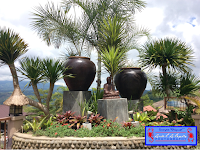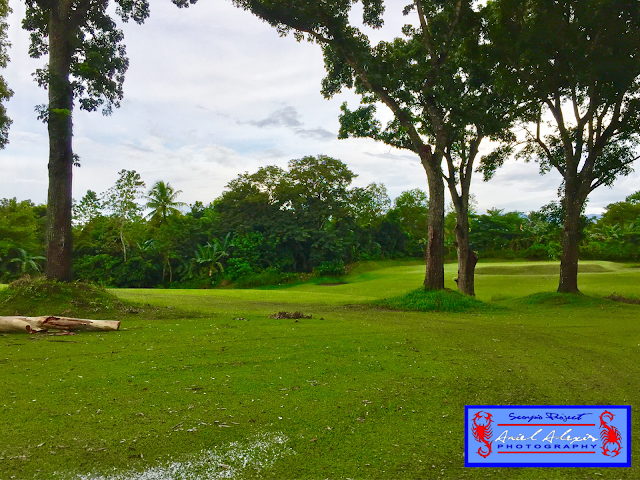It
was the perfect easy-like-Sunday-morning kind of joyride that will probably
hold me spellbound for some time. En route to San Carlos City where my hosts,
Jim and Minnie, along with their son, Migs, were taking me on a quick tour, the
panorama that was unfolding before our eyes was captivating to say the least,
reminding me of the stunning rarities and serpentine roads leading to Baguio,
the Summer Capital of the Philippines.
 |
| A glimpse of Mt. Mandalagan while passing by Murcia |
A
little over an hour down the road, my hosts told me that we were stopping over
every now and then so that I could take pictures of the magnificent scenery up
ahead. The photographer in me was thrilled no end! Mind you, the gracious
couple had to rearrange their schedules that day so that they could take me on
a tour to the northern part of the province—I can’t thank them enough for that!
 In
minutes, we reached the Lion’s Park View Deck along the highway where Jim
pulled over—the perfect spot for capturing the view hundreds of feet below us.
Minnie said I should take as many snaps as I can for posterity’s sake. So,
armed with my smartphone and digicam, I hopped out of the SUV. Minnie followed
me, offering to take my pictures.
In
minutes, we reached the Lion’s Park View Deck along the highway where Jim
pulled over—the perfect spot for capturing the view hundreds of feet below us.
Minnie said I should take as many snaps as I can for posterity’s sake. So,
armed with my smartphone and digicam, I hopped out of the SUV. Minnie followed
me, offering to take my pictures.
 |
 |
 |
 |
 |
 |
Stretched out before us was a breathtaking landscape of verdant mountains blanketed by thick forests, fertile valleys planted with crops, a meandering river and a neat array of rice terraces in one part of the gently sloping terrain. To the right, I saw what looked like a small chapel surrounded by a garden—Padre Pio’s Garden—neatly tucked several meters down below.
 |
| Padre Pio's Garden |
Truly a sight to behold, the picturesque scene is one of the natural treats that had me doting over that part of the province. Snapping out of my trance, I started shooting here, there, and everywhere—wary that I may not have another chance to go back and shoot such mise en scène. Minnie was also busy capturing my every move, telling me to pose once in a while.
 Such
was the awe-inspiring surprise that greeted me that day—the same wonder of
nature awaiting motorists whenever they pass by the serene town named Don
Salvador Benedicto a.k.a. DS Benedicto or DSB, for short. Dubbed as the “Summer
Capital of Negros Occidental”, DSB is one of the 19 municipalities, along with
13 cities, that make up the sugar-producing province.
Such
was the awe-inspiring surprise that greeted me that day—the same wonder of
nature awaiting motorists whenever they pass by the serene town named Don
Salvador Benedicto a.k.a. DS Benedicto or DSB, for short. Dubbed as the “Summer
Capital of Negros Occidental”, DSB is one of the 19 municipalities, along with
13 cities, that make up the sugar-producing province.
 Perched
at 675 m (2,214 ft) above sea level, the town in the highlands, situated 47 km
away from Bacolod City, got its name after the province’s late Vice Governor
Salvador Benedicto, who played a big role in creating the revolutionary
government when Negros Island was occupied by Japanese forces at the height of
World War II.
Perched
at 675 m (2,214 ft) above sea level, the town in the highlands, situated 47 km
away from Bacolod City, got its name after the province’s late Vice Governor
Salvador Benedicto, who played a big role in creating the revolutionary
government when Negros Island was occupied by Japanese forces at the height of
World War II.
 DS
Benedicto, which came into being in 1983, was formed by merging the secluded
villages of two towns and one city that weren’t given much attention given
their distance and inaccessibility. From what I’ve gathered, these included two
villages from Murcia (Pandanon and Igmayaan), three from San Carlos City
(Kumaliskis, Bunga, and Pinowayan-Prosperidad) and another two from Calatrava
(Bagong Silang-Marcelo and Bago-Lalong).
DS
Benedicto, which came into being in 1983, was formed by merging the secluded
villages of two towns and one city that weren’t given much attention given
their distance and inaccessibility. From what I’ve gathered, these included two
villages from Murcia (Pandanon and Igmayaan), three from San Carlos City
(Kumaliskis, Bunga, and Pinowayan-Prosperidad) and another two from Calatrava
(Bagong Silang-Marcelo and Bago-Lalong). We
continued with our sojourn until we reached a portion of the pothole-free
highway with huge Norfolk pine trees lining both its sides. Jim again pulled
over, giving me another chance to take some photos of the amazing landscape.
From where I stood, I saw a nearby forest of evergreens. I walked towards it.
Minnie followed me. Again, more pictures with the pine trees as backdrops.
We
continued with our sojourn until we reached a portion of the pothole-free
highway with huge Norfolk pine trees lining both its sides. Jim again pulled
over, giving me another chance to take some photos of the amazing landscape.
From where I stood, I saw a nearby forest of evergreens. I walked towards it.
Minnie followed me. Again, more pictures with the pine trees as backdrops.
 Our
last stop was at another view deck overlooking the cigarette-shaped Malatan-og
Falls, another must-see in the province. As I stood there, the cold breeze
caressed me, giving me the same chills I’ve experienced in Baguio and Tagaytay!
I looked at my phone for the temp reading—a shivery 18 °C! No wonder everyone
who’s made it to DSB before me was doting over the natural wonders of the
“Little Baguio” of Neg Occ!
Our
last stop was at another view deck overlooking the cigarette-shaped Malatan-og
Falls, another must-see in the province. As I stood there, the cold breeze
caressed me, giving me the same chills I’ve experienced in Baguio and Tagaytay!
I looked at my phone for the temp reading—a shivery 18 °C! No wonder everyone
who’s made it to DSB before me was doting over the natural wonders of the
“Little Baguio” of Neg Occ! |
| The cigarette-shaped Malatan-og Falls |
I’ve
barely scratched DS Benedicto’s surface. If given the chance to go back to Neg
Occ, I’d certainly love to explore this amazing town to the hilt! When that
time comes, I’d like to go on a trek to Malatan-og Falls; bask in the
breathtaking rice terraces; take a bath in the alluring Talos River, explore
the organic farm of Rapha Valley; commune with nature at Villa Ica; and much,
much more! Geez, I can’t wait to do these stuff in the future! 😍😍😍











































